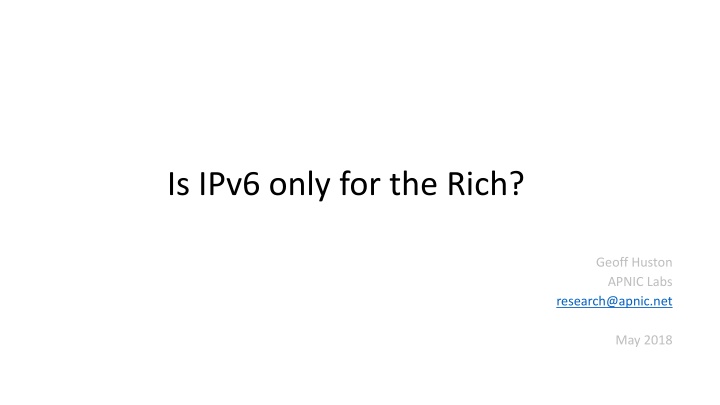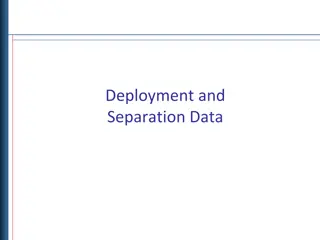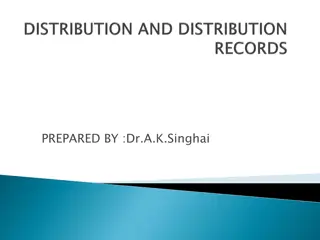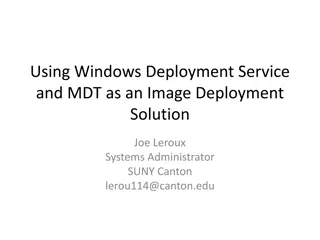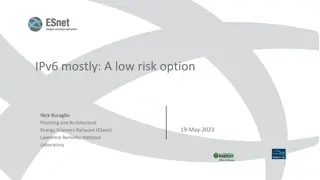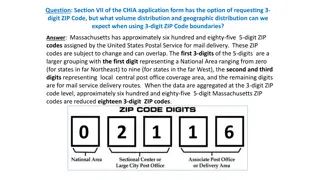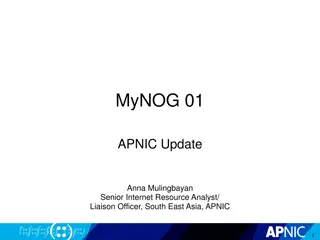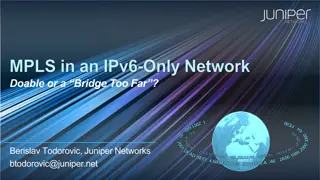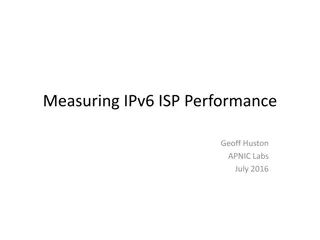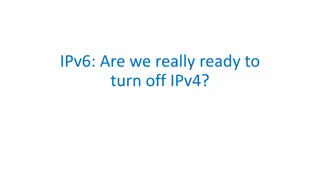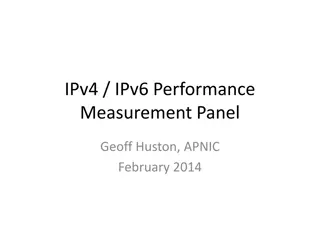IPv6 Deployment Trends and Geographic Distribution
Examination of IPv6 adoption rates, factors influencing growth, and geographic distribution of IPv6 users across various economies. Insights drawn from research conducted by Geoff Huston at APNIC Labs. Analysis covers the slowdown in recent IPv6 deployment, common factors driving adoption, and the distribution of IPv6 users in countries such as India, USA, Germany, Brazil, and others.
Download Presentation

Please find below an Image/Link to download the presentation.
The content on the website is provided AS IS for your information and personal use only. It may not be sold, licensed, or shared on other websites without obtaining consent from the author.If you encounter any issues during the download, it is possible that the publisher has removed the file from their server.
You are allowed to download the files provided on this website for personal or commercial use, subject to the condition that they are used lawfully. All files are the property of their respective owners.
The content on the website is provided AS IS for your information and personal use only. It may not be sold, licensed, or shared on other websites without obtaining consent from the author.
E N D
Presentation Transcript
Is IPv6 only for the Rich? Geoff Huston APNIC Labs research@apnic.net May 2018
Measuring IPv6 Deployment APNIC Labs operates a very large Ad-based measurement system Users are directed to a IPv6-only and a dual stack blot , and their capability is measured IPv6-Capable means that the user can retrieve an IPv6-only web object IPv6-Preferred means that the user used IPv6 to retrieve a dual stack web object The Ad runs at some 10M measurements per day There is a skew to over-present the Ad in some economies we weight the results per-economy to represent an ideal uniform random sample set to compensate for this skew so that we reflect all of the Internet results This tracks the eyeball Internet
IPv6 Capable and Preferred Deployment The Long Term Picture: 2012 to 2018
IPv6 Capable and Preferred Deployment The Long Term Picture: 2012 to 2018 IPv6 in 2017
2017 The most recent 16 months Jan 2017 to Apr 2018
What the? The pace of adoption of IPv6 in the Internet appears to have slowed down over the past 9 months Recent IPv6 deployment is tracking only at the rate of growth of the Internet itself
Why has IPv6 Deployment Growth slowed? One explanation is the factors that are driving IPv6 deployment are no longer as effective as they were What factors have driven IPv6 growth to date? Lets look at the IPv6 network and see what we can establish as common factors behind IPv6 deployment
Where is IPv6? India USA This is the distribution of IPv6 users across the 13 economies with the largest IPv6 using populations. Germany Brazil Japan Ukraine France Canada Can you guess which economy has the largest IPv6 user population? Belgium Republic of Korea Malaysia Vietnam Australia Remainder
Australia 1% Malaysia 1% Where is IPv6? Vietnam 1% Republic of Korea 1% Remainder 7% Belgium 1% Canada 1% India USA Germany Brazil Japan UK France Canada Belgium Malaysia Rep. of Korea Vietnam Australia 242M 117M 30M 30M 28M 17M 12M 7M 6M 5M 5M 4M 3M 44% 21% 6% 6% 5% 3% 2% 1% 1% 1% 1% 1% 1% France 2% Ukraine 3% UK Japan 5% India 44% Brazil 5% Germany 6% USA 22% The percentages in this table reflect the percentage of the total IPv6 user population who have been geolocated into a particular economy
IPv6 Deployment Drivers IPv6 was developed to provide a solution for the projected exhaustion of the free pool of IPv4 addresses We ve exhausted that IPv4 address pool, yet IPv6 is deployed across less than 20% of the Internet Whatever motivated new deployment of IPv6 has not been strongly in evidence in recent months Do we even know common motivations for an ISP to deploy IPv6 across its infrastructure? Let s look at some common theories and see if the numbers support the theory
Theories of IPv6 Deployment You need to be a rich ISP to afford IPv6 deployment
Theories of IPv6 Deployment You need to be a rich ISP to afford IPv6 deployment Let s measure the wealth of an ISP by the aggregate wealth of its customer base Wealth of the customer base can be measured using GDP per capita Aggregate wealth of an ISP s customer base is GDP per capita times the ISP s estimated customer population
Rich ISPs with IPv6 Deployments Rank ISPs by GDP per Capita x Est. Number of Customers 13 of the richest 20 ISPs have IPv6 deployments of 35% or more across their customer bases
Rich ISPs with IPv6 Deployments The 20 richest ISPs as measured by IPv6 deployment vs ISP value
Rich ISPs with IPv6 Deployments The 400 largest ISPs measured by IPv6 deployment vs ISP value
IPv6 is not exclusively deployed by big ISPs in rich countries 73% of IPv6 users are serviced by ISPs outside the richest top 20 Major ISPs with IPv6 deployments with richness rank > 20: Reliance JIO India (40%. Rank: 25) Vodaphone India (3%, Rank: 111) ICLnet India (2.5%, Rank: 129) Claro, Brazil (1.7%, Rank: 53) Kabel Deutschland, Germany (1%, Rank: 31) SK Telecom, Korea (1%, Rank: 56) Sprint, US (1%, Rank: 27) Telefonica Brazil (1%, Rank: 109) Percent of the World s IPv6 User pool Rank order of value of customer base
You dont need to sell services to rich customers to deploy IPv6 But it helps! Outside of China, the correlation of the aggregate wealth of the an ISP s customer base to IPv6 deployment is pretty high But it s not the entire story
Theories of IPv6 Deployment You need to be a rich ISP to afford IPv6 deployment You need to be growing quickly to be forced into IPv6 deployment
Rapidly Growing ISPs ISPs with high growth in their customer base are now under high IPv4 address stress Does this growth-related stress alter their perceptions of the risk / benefits of IPv6 adoption and spur IPv6 deployment?
Aggregate growth of the estimated customer base in the past 16 months Rapid Growing ISPs Rank AS 1 AS131445 2 AS9644 3 AS37075 4 AS38266 5 AS55836 6 AS45271 7 AS132061 8 AS9605 9 AS56047 10 AS21928 11 AS56041 12 AS4761 13 AS33771 14 AS24389 15 AS10507 16 AS23693 17 AS197207 18 AS56048 19 AS5410 20 AS59257 21 AS24203 22 AS30986 23 AS15897 24 AS41202 25 AS9808 26 AS20978 27 AS4818 28 AS45609 29 AS12389 30 AS22394 AS Name AIS3G-2100-AS-AP Advance Wireless Network SKTELECOM-NET-AS SK Telecom ZAINUGAS HUTCHVAS-AS Vodafone Essar Ltd. Telecommunication - Value Added Services RELIANCEJIO-IN Reliance Jio Infocomm Limited ICLNET-AS-AP Idea Cellular Limited REALMOVE-AS-AP Realmove Company Limited DOCOMO NTT DOCOMO INC. CMNET-HUNAN-AP China Mobile communications corporation T-MOBILE-AS21928 - T-Mobile USA Inc. CMNET-ZHEJIANG-AP China Mobile communications corporation INDOSAT-INP-AP INDOSAT Internet Network Provider SAFARICOM-LIMITED GRAMEENPHONE-AS-AP GrameenPhone Ltd. SPCS - Sprint Personal Communications Systems TELKOMSEL-ASN-ID PT. Telekomunikasi Selular MCCI-AS CMNET-BEIJING-AP China Mobile Communicaitons Corporation ASN-BOUYGTEL-ISP CMPAKLIMITED-AS-AP CMPak Limited NAPXLNET-AS-ID PT Excelcomindo Pratama (Network Access Provider) SCANCOM VODAFONETURKEY UNITEL CMNET-GD Guangdong Mobile Communication Co.Ltd. AVEA-TELEKOMUNIKASYON Istanbul DIGIIX-AP DiGi Telecommunications Sdn. Bhd. BHARTI-MOBILITY-AS-AP Bharti Airtel Ltd. AS for GPRS Service ROSTELECOM-AS CELLCO - Cellco Partnership DBA Verizon Wireless CC TH KR UG IN IN IN TH JP CN US CN ID KE BD US ID IR CN FR PK ID GH TR UZ CN TR MY IN RU US Users (4/18) Users (1/17) Growth V6 Deployment V6 Growth 4,949,903 1,047,844 372% 6,924,914 1,521,612 355% 3,712,755 1,021,996 263% 46,470,030 14,332,740 224% 256,083,676 79,115,818 224% 38,185,995 11,901,462 221% 3,056,882 1,035,635 195% 5,145,742 1,826,417 182% 7,061,429 2,579,417 174% 15,074,933 5,725,701 163% 19,375,512 7,379,958 163% 7,544,134 2,889,955 161% 10,914,396 4,199,062 160% 5,245,821 2,018,349 160% 7,366,500 2,936,890 151% 15,129,489 6,043,987 150% 7,219,921 2,897,240 149% 3,676,952 1,479,558 149% 7,451,600 3,015,444 147% 6,145,443 2,567,186 139% 7,356,017 3,083,799 139% 4,197,932 1,762,571 138% 3,906,400 1,653,584 136% 3,232,529 1,375,341 135% 58,907,760 25,705,680 129% 3,470,414 1,521,081 128% 2,645,084 1,161,006 128% 65,933,383 29,499,640 124% 19,056,734 8,626,606 121% 18,137,318 8,289,013 119% 43.9% 82.3% 0.0% 39.4% 92.1% 39.7% 0.0% 8.1% 0.0% 94.0% 0.0% 0.0% 2.0% 0.0% 76.8% 0.0% 0.0% 0.2% 1.9% 0.0% 0.0% 0.0% 0.0% 0.0% 0.0% 0.0% 37.5% 2.5% 0.2% 85.7% 43.9% 56.0% 0.0% 39.4% 19.6% 32.8% 0.0% 8.0% -0.1% 16.2% 0.0% 0.0% 2.0% 0.0% 48.4% 0.0% 0.0% 0.1% 1.9% 0.0% 0.0% 0.0% 0.0% 0.0% -0.3% 0.0% 33.6% 2.4% 0.2% -4.4%
Rapidly Growing ISPs 100 ISPs with more than 1M estimated customers grew their customer base by more than 20% over the past 16 months Only 26 of these ISPs had a IPv6 deployment above 10% of their user base
Rapidly Growing ISPs IPv6 adoption scatter plot for the 100 Fastest growing ISPs
Its probably not Rapid Growth It appears that at present most rapidly growing ISPs (93%) are using IPv4 addressing to sustain their rapid growth and are not making accelerated investments in IPv6-capable infrastructure In other words, rapid growth of an ISP s customer base does not necessarily motivate an accelerated IPv6 deployment
Theories of IPv6 Deployment You need to be a rich ISP to afford IPv6 deployment You need to be growing quickly to be forced into IPv6 deployment You are running very short of IPv4 addresses
Calculating Customers per IPv4 Address for each ISP Use the estimate of the customer population per ISP Analysis of the BGP routing table can give us the number of advertised IPv4 addresses per originating ASN We can then correlate the estimated customer population of an ISP with the span of IPv4 addresses originated by the ISP s ASN to give a ratio of customers per advertised IPv4 address
Customers per IPv4 Address Rank AS 1 2 3 4 5 6 7 8 9 10 11 12 13 14 15 16 17 18 19 20 21 22 23 24 25 26 27 28 29 30 31 AS Name CHINANET-BACKBONE No.31,Jin-rong Street RELIANCEJIO-IN Reliance Jio Infocomm Limited CHINA169-BACKBONE CHINA UNICOM China169 Backbone BHARTI-MOBILITY-AS-AP Bharti Airtel Ltd. AS for GPRS Service IN CMNET-GD Guangdong Mobile Communication Co.Ltd. COMCAST-7922 - Comcast Cable Communications, LLC HUTCHVAS-AS Vodafone Essar Ltd., Telecommunication - Value A IN ICLNET-AS-AP Idea Cellular Limited CHINANET-SH-AP China Telecom (Group) VCG-AS Uninet S.A. de C.V. ATT-INTERNET4 - ATT Services, Inc. GIGAINFRA Softbank BB Corp. CHINA169-BJ China Unicom Beijing Province Network TE-AS TE-AS TTNET CLARO S.A. DTAG Internet service provider operations KDDI KDDI CORPORATION VNPT-AS-VN VNPT Corp OCN NTT Communications Corporation IPG-AS-AP Philippine Long Distance Telephone Company CMNET-JIANGSU-AP China Mobile communications corporation CN VNL1-AS CMNET-ZHEJIANG-AP China Mobile communications corporationCN ROSTELECOM-AS CELLCO - Cellco Partnership DBA Verizon Wireless France Telecom Orange KIXS-AS-KR Korea Telecom CMNET-GUANGDONG-AP China Mobile communications corporat CN globacom-as CC CN IN CN Customers V6 Deployment 314,066,685 258,153,932 168,742,809 63,831,937 59,345,231 49,428,872 46,950,378 37,367,503 33,473,934 31,884,360 29,650,980 27,706,446 25,236,640 24,271,679 24,001,210 23,330,067 23,235,033 23,161,869 21,673,865 21,576,733 20,142,292 19,641,329 19,601,569 19,482,286 19,435,447 18,933,027 17,989,130 16,987,008 16,423,377 16,065,132 15,729,744 IPv4 Addrs 108,130,048 3,593,728 56,185,087 3,922,688 18,679,040 71,070,976 601,344 584,192 8,605,952 80,896 13,811,456 80,676,096 44,918,528 6,845,183 7,063,040 6,905,600 9,154,560 34,148,864 18,765,568 6,419,136 28,889,856 2,433,024 2,576,896 34,560 2,939,904 7,558,912 12,154,112 19,391,488 44,733,472 1,972,224 18,688 Ratio 2.9 71.8 3.0 16.3 3.2 0.7 78.1 64.0 3.9 394.1 2.1 0.3 0.6 3.5 3.4 3.4 2.5 0.7 1.2 3.4 0.7 8.1 7.6 563.7 6.6 2.5 1.5 0.9 0.4 8.1 841.7 AS4134 AS55836 AS4837 AS45609 AS9808 AS7922 AS38266 AS45271 AS4812 AS29465 AS8151 AS7018 AS17676 AS4808 AS8452 AS9121 AS28573 AS3320 AS2516 AS45899 AS4713 AS9299 AS56046 AS36873 AS56041 AS12389 AS22394 AS3215 AS4766 AS56040 AS37148 0.1% 92.0% 0.1% 2.5% 0.0% 73.1% 39.1% 39.4% 0.0% 0.0% 10.6% 80.4% 34.1% 0.4% 0.0% 0.0% 44.1% 61.6% 54.8% 9.6% 27.8% 0.0% 0.0% 0.0% 0.0% 0.2% 85.9% 46.5% 2.4% 0.2% 0.0% 31 Largest ISPs (measured by estimated customer count) CN US IN CN NG MX US JP CN EG TR BR DE JP VN JP PH NG RU US FR KR NG
Customers per IPv4 Address vs IPv6 Deployment 418 Largest ISPs (measured by estimated customer count)
Running Short of IPv4 Addresses 418 ISPs have a customer population of over 1M 81 of these ISPS are not stressed for IPv4 yet: They have more than 1 IPv4 address per customer 31 of these ISPs have a IPv6 deployment rate greater than 5% (38% of these unstressed ISPs) 337 of these ISPs are stressed for IPv4: They have less than 1 IPv4 address per customer 80 of these ISPs have an IPv6 deployment rate greater than 5% (23% of these stressed ISPs) Unusually, those ISPs with a higher level of IPv4 address stress have a lower IPv6 deployment rate
Running very short of IPv4 Addresses 19 ISPs have more than 100 customers per advertised IPv4 address Only 1 of these ISPs has an IPv6 deployment rate of more than 5% (and its stress rate is 100 customers per advertised IPv4 address) Actually, only 1 has an IPv6 deployment more than 0.04% The other 18 ISPs have higher address stress rates of between 135 to 1,370 customers per advertised IPv4 address and negligible IPv6 deployment levels It appears that acute IPv4 address overuse is not a major driver for IPv6 deployment
The Changing Internet IPv6 was designed as a solution to a different Internet The Client / Server CDN-centric Internet does not require each endpoint to have a globally unique permanent address Addresses are increasingly being used in the role of ephemeral session tokens, not as persistent endpoint identifiers This does NOT mean that IPv4 will last indefinitely it won t But it does mean that many areas of the Internet are yet to experience major pressures to deploy IPv6 in a client/server context
Theories of IPv6 Deployment You need to be a rich ISP to afford IPv6 deployment You need to be growing quickly to be forced into IPv6 deployment You are running very short of IPv4 addresses Local conditions
National IPv6 Deployments Economies where 3 or more of the 6 largest ISPs have IPv6 deployment levels > 20%: India (58%) Belgium (58%) USA (44%) Germany (39%) Greece (38%) Japan (27%) Brazil (26%) India shows that competitive factors can drive IPv6 deployment across the major ISPs in a country, but this is not clear in all countries with significant IPv6 deployment
What Drives Deployment of IPv6? There is no major common factor at work here IPv6 deployment is not confined to ISPs in countries with higher GDP per capita to ISPs who are growing their user base the fastest to ISPs that are experiencing the highest levels of IPv4 address stress to national communities However, all these factors appear to help in individual cases
Back to our question The pace of adoption of IPv6 in the Internet appears to have slowed down over the past 9 months What s going on?
Back to our question The pace of adoption of IPv6 in the Internet appears to have slowed down over the past 9 months What s going on? We really don t know!
